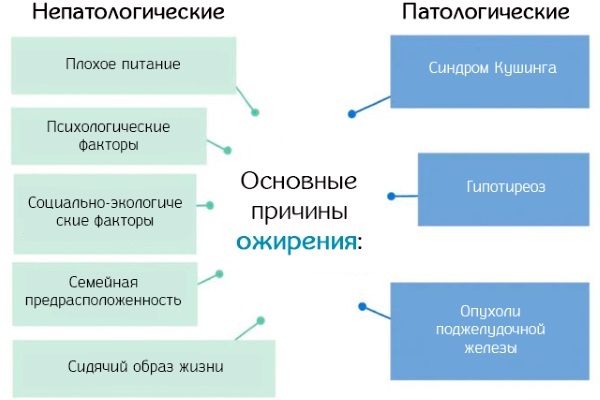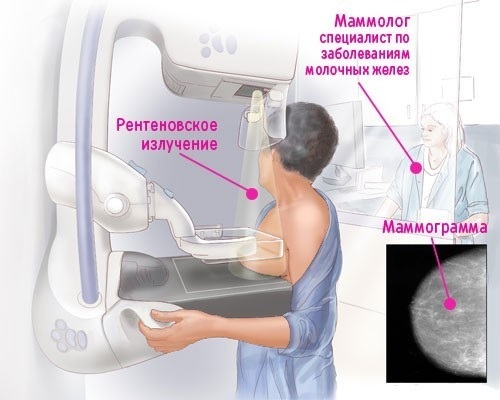Gigantomastia is a rare disease in which there is a pathological proliferation of connective tissue in the area of the mammary glands. A benign tumor forms, the dimensions of which can be seen in the photo on the Internet.
A woman's breasts are increased to large volumes. Treatment in most cases involves surgery. Without therapy, the patient will face serious consequences, including death, as a result of an infectious lesion or cardiovascular failure.
Record content:
-
1 Views
- 1.1 Aggressive
- 1.2 Sluggish
- 1.3 Abortive
- 2 Stages and degrees
- 3 Symptoms and Signs
- 4 Causes
- 5 Diagnostics
-
6 Elimination methods
- 6.1 Drug therapy
- 6.2 Operation
- 7 Possible consequences and complications
- 8 Video about gigantomastia
Views
In medicine, gigantomastia in women is classified in a certain way, taking into account the accompanying signs and existing disorders in the patient's body:
Aggressive
A disease that is more often diagnosed in women from 18 to 23 years old. The pathological condition is characterized by the rapid growth of the breast.
The skin cannot quickly adapt, so wounds on the woman's body, bruises and stretch marks appear as accompanying symptoms. Nipples change their shape. The chest sags down. A woman cannot get pregnant. A sharp and heavy load on the spine provokes severe pain in the chest and shortness of breath.
Sluggish
Gigantomastia is characterized by a slow enlargement of the mammary glands over several years. The sluggish form is more often diagnosed in women aged 30 years.
There are no pronounced symptoms. There are no stretch marks, the chest hangs ugly. The load on the spinal column also gradually increases, resulting in severe pain in the lumbar region. Posture deteriorates.
Abortive
A form of gigantomastia, which occurs more often while taking certain medications. In most cases, women are faced with this disease over 30 years.
Hormonal imbalance provokes an increase in the mammary glands, but there is no swelling. Timely diagnosis of the disease and properly selected treatment will stop the development of changes and restore the natural shape of the breast.
Each type of gigantomastia in women is accompanied by characteristic clinical symptoms, with which it is necessary to consult a gynecologist or mammologist. The specialist will conduct an examination, prescribe a comprehensive examination and draw up the most effective treatment regimen.
Stages and degrees
Gigantomastia in women (photos of pathological foci and the boundaries of their distribution will help to obtain instrumental examination methods) also differs in severity. In this situation, the classifying feature is the volume of the mammary glands. The larger the breasts, the more neglected the disease.
| The size | Description |
| 0-2 | The volume is 250-300 ml. The condition of the mammary glands is satisfactory. |
| 3-4 | We are talking about a mild form of hypertrophy of the glandular tissue, the volume of which in this situation reaches 600 ml. |
| <6 | The average degree of hypertrophy of the mammary glands. The volume is 800 ml. |
| <8 | Severe hypertrophy, characterized by a volume of 1200 ml. |
| 8 and up | At this stage, the diagnosis of gigantomastia is established. The volume of glandular tissue is 1200 ml or more. |
The described classification shows that women with 3 breast sizes and above are already at risk. Any negative provoking factor can cause the development of pathological processes. Therefore, it is important to visit a gynecologist or mammologist for preventive purposes in order to timely identify the disease.
Symptoms and Signs
The accompanying signs that arise with gigantomastia will help the doctor establish a preliminary diagnosis and prescribe the woman the most informative examination.

Symptoms of the pathological condition are as follows:
- there is a rapid or spontaneous breast enlargement during puberty, also during pregnancy;
- there is a strong pain syndrome and discomfort in the area of the mammary glands;
- one or two breasts are enlarged at once;
- posture is disturbed;
- the local temperature rises;
- the skin turns red;
- itching occurs;
- painful sensations in the neck, shoulders and back;
- subcutaneous blood vessels appear on the chest;
- characteristic discharge, transparent or white, appears from the mammary glands;
- it is difficult for a woman to move;
- the mammary glands are straining;
- stretch marks appear on the skin;
- the menstrual cycle is disrupted.
Gigantomastia in women (a photo of the pathological condition of the mammary glands can be seen on the Internet) provokes chronic stretching of the intercostal nerves. For this reason, the areoles and nipples are enlarged, they are displaced. Lactation during breastfeeding is also impossible, since the flow in the mammary glands is blocked. Mastitis develops and the process of feeding the baby is disrupted.
Causes
The main provoking factor in the development of gigantomastia in women is hormones (estrogen and androgen), namely, a change in their concentration. This fact is influenced by numerous sources, including the use of medicines without a doctor's prescription, the ingress of toxic substances into a woman's body. The same applies to diseases that are accompanied by systemic manifestations.
The causes of the pathological condition in women are as follows:
- hormonal imbalance;
- obesity of varying degrees;

- puberty;
- increased sensitivity of the female body to the hormones produced;
- hereditary predisposition;
- side effect after using certain medications;
- increased production of hormones in a woman's body while carrying a child;
- autoimmune disorders (myasthenia gravis, chronic arthritis).
Gigantomastia in women is also a consequence of an infectious lesion of the mammary glands. The same goes for long-term emotional distress and stressful situations.
Diagnostics
The diagnosis and treatment of gigantomastia is carried out by a gynecologist, since we are talking about the reproductive function of the female body. The patient is prescribed a comprehensive examination to establish the diagnosis and cause of the pathological condition. Given the results obtained, a woman may need additional consultation with a mammologist, oncologist, endocrinologist, surgeon.
Comprehensive diagnostics for gigantomastia provides for the following activities:
| Name | Description |
| General and biochemical blood test | Specialists assess the functioning of the thyroid gland, determine the level of calcium and hormones. Research is also being conducted to establish autoimmune disorders in a woman's body. |
| Ultrasound examination (ultrasound) | A diagnostic method by which the mammary glands are examined for the detection of pathological foci. |
| Mammography | The most informative examination method that allows you to determine the pathological processes in the area of the mammary glands at an early stage of development, including malignant changes. The specialist examines the glandular structure of the breasts. |
| Histological examinations | The results make it possible to determine pathological changes in the mammary glands, including expansion of the milk ducts, proliferation of glandular tissue, and the formation of collagen fibers. |
| Immunohistochemical test | Microscopic method for studying breast tissue, which makes it possible with a high degree of probability to determine malignant or benign processes in the female body. |

A correctly made diagnosis is important for specialists, since the tactics of treatment depend on the data obtained.
Elimination methods
Gigantomastia in women (photo pictures after the results of ultrasound or mammography will help to establish the size of the pathological focus) in most cases is treated surgically.
In many women, after pregnancy or stopping hormonal drugs, the size of the mammary glands is restored on their own. Treatment is prescribed if a pathological factor is detected.
Drugs are used that reduce the level of hormones and stop their production. In some situations, physiotherapeutic procedures (UHF, laser treatment, inductophoresis, mud applications) act as auxiliary therapy. In the absence of positive dynamics or in the event of complications, the patient is indicated for surgical intervention.
Drug therapy
The mammologist selects medicines individually for each woman. Not only the test results are taken into account, but also related complaints, characteristics of the body. The specialist recommends strictly adhering to the dosages in order to prevent the occurrence of an adverse reaction.
When gigantomastia appears, the following medications are prescribed for women:
| Drug group | Name | Application |
| Antibacterial agents | Azithromycin, Wilprafen | Drugs are prescribed for women with infectious lesions of the mammary glands. It is preferable to take the medicine 1 hour before meals or after a meal 2 hours later. The course of treatment depends on the condition of the woman and lasts an average of 3-5 days. The daily dosage is 250-500 mg. |
| Dopamine receptor agonists | Bromocriptine, Cabergoline | Medication does not reduce breast size, but stops breast enlargement. The tablets must be taken orally with meals, washed down with a little water. To restore hormonal levels, a woman is prescribed 1.25-2.5 mg 2-3 times a day. The minimum course of therapy is 7 days. |
| Hormone antagonists | Tamoxifen, Parlodel | Medicines restore hormonal levels and reduce the sensitivity of receptors to hormones. A woman is prescribed 20 mg per day. It is important to swallow the tablets whole, do not chew them and drink them with water. The effectiveness of the treatment is noticeable after 4-10 weeks. |
| Antigonadotropes | Danazol, Danoval | The drug is taken orally. The daily dosage for a woman depends on her condition and is 200-800 mg. The indicated volume of the medication must be divided into 2-4 doses. Treatment lasts 4-6 months. |

In most cases, drug therapy can achieve only a temporary effect. After the end of the course of treatment, after a while, against the background of provoking factors, the disease returns again. Therefore, the main therapy is surgery.
Operation
Gigantomastia in women rarely requires complex treatment. The drugs give little effect and for a short period of time. Photos of the gradually growing mammary gland can be seen on the Internet in order to draw conclusions and go to the hospital in a timely manner.
Surgical treatment for gigantomastia in women is a priority treatment method. Before the operation, the patient undergoes a thorough examination and preparation. Comprehensive diagnostics are shown without fail in order to exclude contraindications and establish an accurate diagnosis.
The surgeon chooses the method of surgical intervention, taking into account the patient's condition and the test results:
| Name | Description |
| Reduction mammoplasty | Surgical treatment involves the reduction of the mammary glands. The surgeon removes adipose and glandular tissue without affecting the milk ducts. After such an operation, a woman can breastfeed her baby in the future. |
| Mastectomy | Surgical treatment is a radical method, it is prescribed mainly in the case of the development of aggressive gigantomastia. The surgeon removes the breasts completely. Implants are installed in their place. |
| Mastectomy with implant placement | A rare type of surgical treatment, since after the installation of an artificial element, there is a high risk of complications. |

After surgery, a woman is prescribed for life special medications that will help reduce the production of hormones and prevent a recurrence of the disease.
There are certain contraindications to surgical treatment:
- acute or chronic diseases that are in the active stage;
- heart defects;
- the age of the patient who has not reached the age of 18;
- the presence of HIV infection, AIDS.
Girls who have not reached the age of majority, even with the permission of their parents, cannot undergo surgical treatment. It is not recommended to postpone the operation, especially if the woman plans to have children in the future. Mammoplasty allows you to preserve not only the sensitivity of the nipple, but also the ability to breastfeed the baby.
Possible consequences and complications
Gigantomastia in women (photos of the mammary glands at an early stage of the disease will make you think and contact hospital for diagnosis) does not always bring pleasure and attention from the male half humanity.
If the reason for the rapid increase in breasts is a pathological factor, it is necessary to undergo a comprehensive diagnosis and treatment. Otherwise, unpleasant consequences await the woman. It is not only difficulties with the choice of underwear or the excessive attention of men.
Large breasts will negatively affect a woman's health. All vertebral sections will be under heavy load. A complication is a gradual deterioration in posture. Painful sensations will become chronic. The straps of the bra cut into the body and cause severe discomfort.
Physical activity and any activities with large breasts are impossible. It cannot be locked to avoid painful and uncomfortable movement when running, jumping or bending.
Sweat will cause diaper rash on the body, which will turn into wounds without proper personal hygiene. Large breasts will become an obstacle in the diagnosis of tumor neoplasms.
It will be difficult for the doctor to identify the seal during palpation. This is especially important in cases where there is a risk of degeneration of the affected tissues, as a result of which malignant processes appear. Therefore, timely diagnosis and surgery will help to avoid unpleasant consequences.
It is easier to prevent gigantomastia in a woman than to fight it, especially at an advanced stage. There is always the likelihood of serious complications that can be seen in the photo on the Internet.
And simple doctor's advice will help to prevent the disease. It is enough for women to lead a healthy and active lifestyle. If there is a risk or hereditary predisposition, for preventive purposes, visit a specialist and undergo examination.
Video about gigantomastia
Breast reduction surgery:



